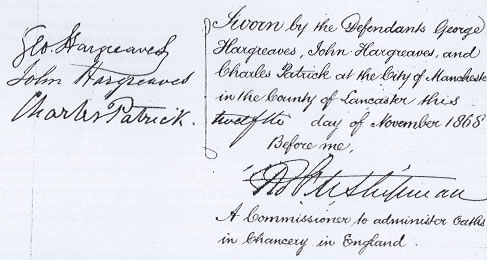Charles Patrick was appointed 1852 as sub-inspector of factories for the Rochdale district.
Established to enforce the 1833 Factories Act, inspectors and sub-inspectors of factories were empowered to enter premises and investigate breaches. They also advised on safety procedures and helped develop new regulations. Gradually their responsibilities extended from textile factories to most workplaces and is part of the history of the development of the Health and Safety Executive. The parliamentary debate records the opposition of many mill masters to the system of sub-inspectors, fearing many were industrial spies as well as resenting the inspection. Sub-inpsectors were to be men of 'intelligence and integrity' and in 1864 were paid c. £300/yr at a time when the average wage was said to be £115 (Mitchell, British Historical Statistics) and the Patricks' quarter share of the colliery profits were £3547.
This work generated a large number of prosecutions of mill owners which were reported in local newspapers. There are too many of these to transcribe them all and the link on the left leads to some examples which cover the broad range of the sub-inspector's activities. These include:
Amongst these is an example of a manager attempting to plead ignorance and a owner who was acquitted when it was demonstrated that Patrick had set his watch by the wrong clock.
A transcript of an inspection in Glossop is included because it details the history, process and difficulties in conducting inspections. A further transcript describes Patrick investigating lacemakers in Northamptonshire, in which he is described as being 'of Brigstock." I have not been able to explore this further.
In addition to factory work, Patrick also inspected Strangeways following complaints by the debtors about their treatment there.
In May 1889 he bought Gordon Works, Piercy, Waterfoot with J R Brooks, slipper manufacturer. (Bacup and Rawtenstall News 18 May 1889). He had retired from the factory inspectorate by this time.
He acquired an interest in Rossendale and Baxenden collieries through his marriage and was involved in the chancery dispute in 1867-70. His signature, below, comes from these documents.
He also had in interest in a stud farm, the failure of which led to the bankruptcy of two of his two co-directors.
Established to enforce the 1833 Factories Act, inspectors and sub-inspectors of factories were empowered to enter premises and investigate breaches. They also advised on safety procedures and helped develop new regulations. Gradually their responsibilities extended from textile factories to most workplaces and is part of the history of the development of the Health and Safety Executive. The parliamentary debate records the opposition of many mill masters to the system of sub-inspectors, fearing many were industrial spies as well as resenting the inspection. Sub-inpsectors were to be men of 'intelligence and integrity' and in 1864 were paid c. £300/yr at a time when the average wage was said to be £115 (Mitchell, British Historical Statistics) and the Patricks' quarter share of the colliery profits were £3547.
This work generated a large number of prosecutions of mill owners which were reported in local newspapers. There are too many of these to transcribe them all and the link on the left leads to some examples which cover the broad range of the sub-inspector's activities. These include:
- falsification of records of school attendance
- employing women and children outside the hours of 6 am and 6 pm
- failure to fence shafts or gearing
- safety inventions
- failure to register female workers
- failure to obtain medical certificates
- working over break times
- submissions to Factory Acts Commissioners.
Amongst these is an example of a manager attempting to plead ignorance and a owner who was acquitted when it was demonstrated that Patrick had set his watch by the wrong clock.
A transcript of an inspection in Glossop is included because it details the history, process and difficulties in conducting inspections. A further transcript describes Patrick investigating lacemakers in Northamptonshire, in which he is described as being 'of Brigstock." I have not been able to explore this further.
In addition to factory work, Patrick also inspected Strangeways following complaints by the debtors about their treatment there.
In May 1889 he bought Gordon Works, Piercy, Waterfoot with J R Brooks, slipper manufacturer. (Bacup and Rawtenstall News 18 May 1889). He had retired from the factory inspectorate by this time.
He acquired an interest in Rossendale and Baxenden collieries through his marriage and was involved in the chancery dispute in 1867-70. His signature, below, comes from these documents.
He also had in interest in a stud farm, the failure of which led to the bankruptcy of two of his two co-directors.





